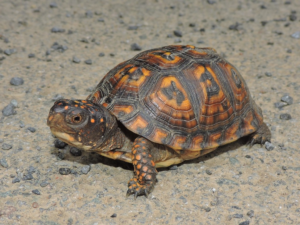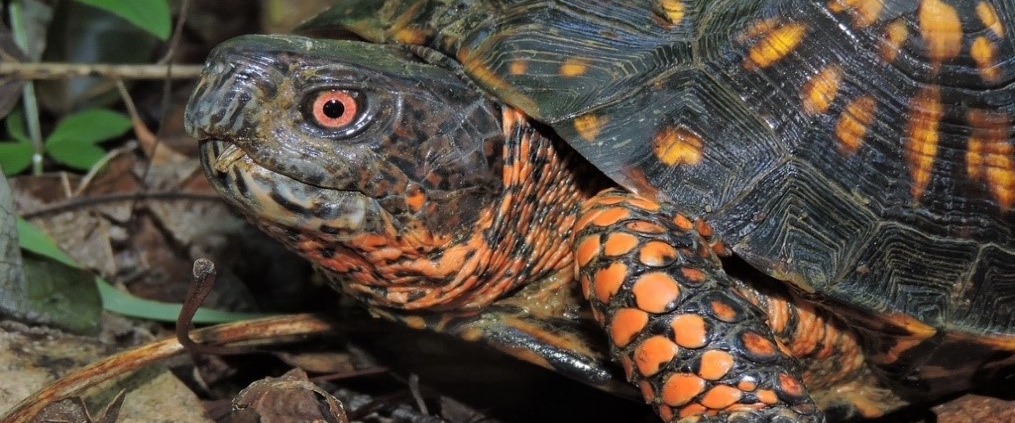Near to Nature: Meeting Our Tennessee State Reptile
Thinking Outside the Box
The Eastern Box Turtle (Terrapene carolina) roams the summer forests of Bays Mountain and is usually found lumbering across the trail on early morning strolls. “Box turtles” get their common name from an ability to tightly close their shell, thanks to a hinged plastron (bottom of the shell). They have stump-like legs with scales like tree bark; a thick, protective shell that resembles a rock. When threatened, they close both ends of the shell securely, barring raccoons, opossums, and skunks from eating the turtle inside.
Some have piercing red eyes and fiery markings on the shell; others are shier and more secretive, with long, drooping necks and translucent beaks to cut through vegetation and soft-bodied insects. As they walk across the forest floor, box turtles blend in with the umbrage of the canopy’s shadow, with flecks of beautiful orange, yellow, and black forming colorful patterns that also serve as camouflage.
A terrestrial turtle, the box turtle is usually found lumbering across the trail on early morning strolls. it cannot swim or survive in local ponds and rivers like other species. Instead, the box turtle has a domed shell and tortoise-like body. They spend most of their time in bottomland forests, walking methodically across a small territory in search of food. Capable of living for over a century, each box turtle lives in a home area of only a few square miles. Male box turtles have red eyes and a curved plastron, while females have brown eyes and a flat plastron.
Every year in early summer, the males begin searching for mates and start to cross their home area. Females also travel like this to lay their eggs, and the loss of mature females is even more dangerous for a population. It can take over a decade for a turtle to reach maturity, from her hatch to first clutch of eggs, so the loss of one adult can severely damage a small population. However, since many roads and neighborhoods intersect this habitat, many box turtles are killed by cars, pets, and habitat destruction. Sometimes, females can be found excavating nests in warm, sandy, or well-drained soil, laying her leathery eggs a few inches below the surface. On the mountain, box turtles are lucky to have remaining habitat large enough for their short, meandering migrations to occur naturally.
If you spot a turtle crossing the road, you can help it! First, ensure that it will be safe to pull off to the side, and that you will not be in danger of being struck by a vehicle. If the road is clear, walk up to the box turtle and grasp it around the sides of the shell. Lift it gently and place it on the side of the road it was facing. Even if it is steep, or seemingly impassible, still place it on that side. If you return it to the side from which it came, it will simply cross the road again (slightly confused about being displaced). Never move the turtle or try to keep it as a pet; each turtle is very important to its own patch of territory, and turtles moved from their usual habitat often die when relocated. Also, it is illegal to keep wild-caught, native turtles in the state of Tennessee, especially box turtles, which are difficult to care for and becoming scarcer with increasing traffic on the roads.

A juvenile female Eastern Box Turtle. Notice her brown eyes. Juveniles also have more of a caramel-brown coloration as they develop the intricate patterns of the adults.
Box turtles mainly eat slugs, worms, berries, flowers, fungi, and insects. In fact, they’re immune to toxic mushrooms, and can repurpose the toxins to defend themselves against predators. As box turtles eat the seeds of low, berry-producing plants like dewberries (Rubus flagellaris), wild strawberries (Fragaria virginica), and others, they also eat the seeds. Since they carry these seeds on their journeys, box turtles spread seeds through their scat. Like peaceful, ancient gardeners, box turtles “cultivate” many low, creeping vines and bushes by munching on their fruits. They also eat various garden pests, and clean up rotting fruit, so they are helpful animals to have living in forests surrounding people. Box turtles can be tracked by following “V-shaped” cuts in leaves, mushrooms, and fruits; the marks left cleanly by the turtle’s strong beak.
Their unique life history, and importance to the ecosystems of our state, have earned them the title of “State Reptile” in Tennessee. At Bays Mountain, box turtles thrive in the hemlock, oak, and tulip-tree woods fringing the lake, sauntering across the forest floor quietly and often unseen. These special treasures are only one of many reasons the mountain is such a wonderful place to watch Tennessee’s fascinating ecosystems at work. Remember to keep an eye peeled for them on your next trip to the mountain!







